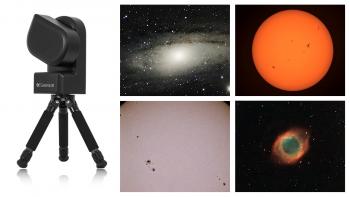Seestar S50

- School:
- Alternative Schools
- Subject:
- Science
- Teacher:
- Richard (Bart) Thomas
- Students Impacted:
- 1000
- Grade:
- 9-12
- Date:
- August 30, 2024
0% Funded
Only $1,509.65 Needed
Goal
A smart telescope is an electronic device that uses digital technology, like cameras to make stargazing easier. The Seestar smart telescope integrates a telescope, electric focuser, astronomical camera, altazimuth mount, dew heater and filter all weighing only 2.5 kg. It contains the ASIAIR that controls the equipment. The Seestar is easy to set up. You can start taking astrophotos within a few minutes. The Seestar is lightweight and portable. It uses its own Wifi to send images to an app on your phone or iPad. The Seestar comes with a solar filter. Students can take photos of the sun, moon, and deep space objects. When looking through a regular telescope the image looks like a smudge of light. The goal is for students to see and take quality images of astronomical objects within a short amount of time.
Category
Electronics - Personal computers/tablets/iPads, headphones, charging cables, computer mice, etc.
What will be done with my students
Students will learn how to set up the Seestar in order to look at and photograph celestial objects. Once the Seestar is connected to the app, students can pick the celestial object they want to see on the phone or iPad. The students can choose from different exposure times. Once the student(s) understands the basic app controls, they can quickly slew to different celestial objects. During school hours, students will be looking at an image of the sun with the two different solar filters. The students can determine the rotation rate of the sun by monitoring the sunspots. Students can also take a photo of the moon, if visible, during daytime hours.
Benefits to my students
Once a student is connected to the Seestar they can slew to a target, focus, and launch an image sequence. An iPad is a really good visual way for the student to see the image “unfold” in real time. Students can see the stacking of photos live on their device. The signal to noise ratio is reduced in real time and students can see a clearer image. The Seestar takes only a few minutes to slew from one object to another object. The Seestar comes with a solar filter to take images of the sun. This is ideal since we are very close to the solar sunspot maximum. An additional solar filter will be purchased to see the sun in a different color. The Seestar image will be seen on a phone or iPad which can be wirelessly connected to a monitor via the Apple TV. The images can be put together to create a final image that students can share with others.
Budget Narrative
With a large number of students it is important for many students to see the image at one time. The apple tv 4k wirelessly connects to a larger monitor. I can put the larger monitor in shade for better image contrast. The tripod leveler is recommended by all who use the Seestar. The leveling is important so that the Seestar can find the object and then keep the object in the field of view. Although a solar filter comes with the Seestar, the Baader filter is used to see the sun in a different color. This filter works well. The accessory kit contains a dew shield/solar finder, a threaded filter holder, a Bahtinov mask , and a lens cap. The narrow band filter is used when taking photos of deep sky objects to help reduce light pollution.
Items
| # | Item | Cost |
|---|---|---|
| 1 | Seestar S50 | $524.96 |
| 2 | Apple TV 4k | $137.79 |
| 3 | iPad Mini | $406.59 |
| 4 | Tripod Leveling Head | $30.42 |
| 5 | AST Core See Star Accessoriesr | $32.04 |
| 6 | S50 Baader Solar Filter | $37.59 |
| 7 | IDAS NBZ2 2" filter | $340.26 |
| Total: | $1,509.65 |
0% Funded
Only $1,509.65 Needed



Share
Please share this page to help in fulfilling this grant.
Email to a Friend